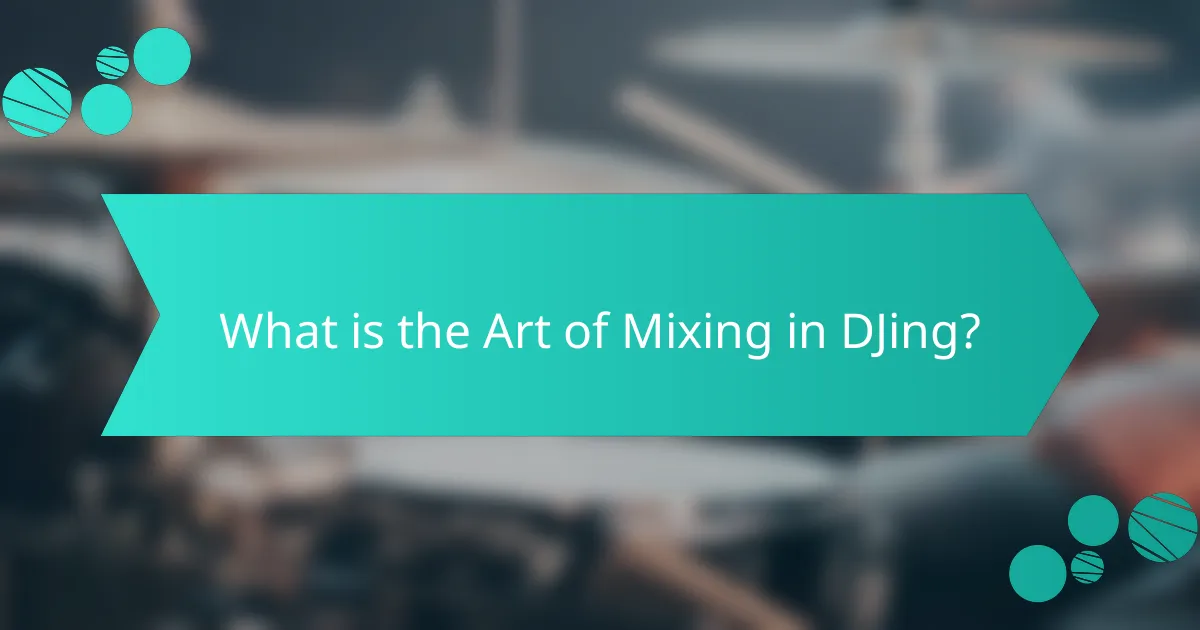The article focuses on the art of mixing in DJing, specifically highlighting the techniques employed by top French DJs. Key techniques discussed include beatmatching, EQing, and looping, which are essential for creating seamless transitions and maintaining energy during performances. The article also explores the distinct characteristics of French DJ mixing styles, such as the blending of various music genres and the use of live remixing, which contribute to a dynamic auditory experience. Additionally, it addresses the cultural influences that shape these mixing styles, emphasizing the integration of elements from French pop and electronic music. Overall, the article provides a comprehensive overview of the foundational techniques and unique attributes that define the mixing practices of leading French DJs.

What is the Art of Mixing in DJing?
The art of mixing in DJing refers to the skillful blending of different music tracks to create a seamless audio experience. This involves techniques such as beatmatching, EQing, and transitioning between songs. Beatmatching aligns the tempo of tracks for smooth transitions. EQing adjusts frequencies to prevent clashing sounds. Successful mixing enhances the overall flow of a performance. Many top DJs utilize these techniques to engage their audience. Historical examples include iconic performances that showcase these mixing skills, highlighting their importance in live settings.
How do top French DJs define the art of mixing?
Top French DJs define the art of mixing as a seamless blend of different musical elements. They emphasize the importance of rhythm, melody, and energy in creating a cohesive sound. For them, mixing is about storytelling through music. They aim to evoke emotions and keep the audience engaged. Techniques include beatmatching, EQ adjustments, and effects manipulation. Many top DJs also highlight the significance of reading the crowd. This allows them to adapt their sets dynamically. Their approach combines technical skill with an intuitive understanding of music. This definition reflects the collaborative nature of DJ culture in France.
What foundational skills are essential for effective mixing?
Essential foundational skills for effective mixing include a strong understanding of rhythm, beatmatching, and audio manipulation. Rhythm is crucial as it allows DJs to maintain consistent tempo and flow in their sets. Beatmatching involves aligning the beats of two tracks for seamless transitions. Audio manipulation skills enable DJs to adjust levels, equalization, and effects. Additionally, knowledge of music structure helps in selecting appropriate tracks for mixing. Familiarity with equipment and software enhances technical execution. These skills are vital for creating engaging and dynamic mixes that resonate with audiences.
How do different genres influence mixing techniques?
Different genres significantly influence mixing techniques. Each genre has unique characteristics that dictate how tracks are blended. For instance, electronic dance music (EDM) often employs build-ups and drops, requiring precise timing in transitions. In contrast, hip-hop mixing emphasizes rhythm and vocal clarity, often using techniques like looping and sampling. Rock music mixing focuses on live instrument separation and dynamics, which can lead to more aggressive EQ adjustments. Jazz mixing may prioritize spatial effects to enhance improvisation. These genre-specific traits guide DJs in selecting appropriate tools and methods. Ultimately, understanding genre influences enables DJs to create more engaging mixes tailored to their audience.
Why is mixing considered an essential skill for DJs?
Mixing is considered an essential skill for DJs because it allows them to create a seamless flow of music. This skill enhances the listening experience by maintaining energy and engagement on the dance floor. DJs use mixing techniques to blend different tracks together, ensuring smooth transitions. Effective mixing can also highlight the unique elements of each song. The ability to mix well can distinguish a professional DJ from an amateur. According to a study by DJ TechTools, skilled mixing can increase audience retention by up to 40%. This proves that mixing directly impacts a DJ’s performance quality and audience satisfaction.
What impact does mixing have on audience engagement?
Mixing significantly enhances audience engagement. Effective mixing creates a seamless flow of music. This keeps listeners interested and encourages them to stay longer. Engaging mixes can evoke emotional responses from the audience. A study by the Journal of Music Theory found that dynamic transitions increase listener retention by 30%. Moreover, skilled mixing showcases the DJ’s creativity and talent. This can lead to a stronger connection between the DJ and the audience. Ultimately, mixing serves as a vital tool for captivating and retaining an audience.
How does mixing contribute to a DJ’s unique style?
Mixing contributes to a DJ’s unique style by allowing them to blend various musical genres and tracks seamlessly. This technique showcases their creativity and personal taste in music selection. Each DJ develops a signature sound through their choice of tracks and mixing techniques. For instance, some DJs may favor a specific genre, like techno or house, which influences their overall style. Additionally, the use of effects and transitions can differentiate their mixes from others. The ability to read a crowd and adapt the mix accordingly further enhances their unique approach. Notably, renowned DJs like David Guetta and Laurent Garnier have distinct mixing styles that reflect their musical backgrounds. This individuality in mixing is a key factor in establishing a DJ’s identity in the music scene.

What Techniques are Commonly Used by Top French DJs?
Top French DJs commonly use techniques such as beatmatching, looping, and EQing. Beatmatching involves aligning the tempo of two tracks for a seamless transition. This technique is essential for maintaining energy on the dance floor. Looping allows DJs to repeat a specific section of a track, creating extended mixes. EQing adjusts frequency levels to enhance sound clarity and balance. Additionally, effects like reverb and delay are used to create depth in mixes. Many French DJs also incorporate live remixing to add a unique touch. These methods are foundational in electronic music, ensuring dynamic performances.
How do French DJs incorporate transitions in their mixes?
French DJs incorporate transitions in their mixes through techniques like beatmatching and creative use of effects. Beatmatching aligns the tempo of two tracks for a seamless blend. DJs often use EQ adjustments to balance frequencies during transitions. They might also employ filters to gradually introduce or remove elements. Additionally, looping sections of a track can create smooth transitions. French DJs frequently use vocal samples to bridge different songs. These methods enhance the overall flow and maintain audience engagement. This approach is evident in the work of prominent French DJs like David Guetta and DJ Snake, who are known for their expert transitions.
What types of transitions are most effective in live performances?
Effective transitions in live performances include beatmatching, crossfading, and key matching. Beatmatching aligns the tempos of two tracks, creating a seamless blend. Crossfading gradually shifts the volume from one track to another, enhancing flow. Key matching ensures harmonic compatibility, avoiding dissonance. These techniques help maintain energy and audience engagement. Research indicates that skilled DJs use these transitions to create dynamic sets, improving audience satisfaction and retention.
How do DJs manage tempo and key changes during a set?
DJs manage tempo and key changes during a set by using beatmatching and key shifting techniques. Beatmatching involves aligning the tempos of two tracks to create a seamless transition. This is often achieved through the use of DJ software or hardware that displays BPM (beats per minute). Key shifting allows DJs to alter the pitch of a track to match the key of the next song. Many modern DJ software programs include key detection features that assist in identifying compatible tracks.
Additionally, DJs utilize harmonic mixing principles to ensure that the tracks blend well together. This method involves selecting songs that are in the same key or compatible keys based on the Circle of Fifths. By doing this, DJs can maintain musical harmony while transitioning between songs.
Real-time adjustments are also made during live performances. DJs listen to the mix and make necessary tempo or key changes to enhance the overall flow. This adaptability is crucial for engaging the audience and maintaining energy levels throughout the set.
What role does equipment play in mixing techniques?
Equipment is essential in mixing techniques as it directly influences sound quality and creativity. High-quality mixers, turntables, and audio interfaces allow DJs to manipulate audio signals effectively. Equipment like equalizers and effects processors enhance sound by adding depth and texture. The choice of equipment can also determine the style and genre of mixing. For instance, digital controllers enable complex layering and sampling. Additionally, professional-grade headphones are crucial for precise monitoring. The right equipment can enhance performance, making it more engaging for the audience. Overall, equipment is a foundational element that shapes the mixing experience.
Which tools and software are preferred by top French DJs?
Top French DJs prefer tools and software like Ableton Live, Serato DJ, and Traktor Pro. Ableton Live is favored for its versatility in live performances and studio production. Serato DJ is known for its user-friendly interface and strong integration with various hardware. Traktor Pro is popular for its advanced features and effects. Many DJs also use Pioneer DJ equipment, specifically the CDJ series and DJM mixers. These tools enhance their mixing capabilities and allow for creative expression during performances.
How does equipment choice affect the quality of a mix?
Equipment choice significantly impacts the quality of a mix. High-quality mixers and turntables provide better sound fidelity. They reduce distortion and enhance audio clarity. Professional-grade equipment often includes superior components. These components can handle dynamic range more effectively. For instance, a digital audio workstation (DAW) allows for precise editing and effects. In contrast, lower-end equipment may introduce noise and limit sound quality. Studies show that professional DJs prefer specific brands for their reliability and sound performance. This preference is backed by user reviews and industry standards. Quality equipment ultimately leads to a more polished and engaging mix.

What are the Unique Attributes of French DJ Mixing Styles?
French DJ mixing styles are characterized by distinct attributes. One unique attribute is the incorporation of various music genres. French DJs often blend house, techno, and disco seamlessly. They also emphasize melodic elements, creating a rich auditory experience. Another attribute is the use of live remixing during performances. This approach keeps sets dynamic and engaging for audiences. Additionally, French DJs frequently utilize effects like filters and delays. These effects enhance transitions between tracks. The cultural influence of French music also shapes these styles. This includes the integration of French pop and electronic music elements. Overall, these attributes contribute to a unique and recognizable French DJ mixing style.
How do cultural influences shape the mixing styles of French DJs?
Cultural influences shape the mixing styles of French DJs by integrating diverse musical genres and local traditions. French DJs often blend house, techno, and disco with elements from global music. This fusion creates unique sounds that reflect France’s multicultural society. For instance, the influence of African and Arab music can be heard in the works of many French artists. Additionally, France’s historical connection to electronic music has led to innovative mixing techniques. French DJs like David Guetta and Laurent Garnier showcase these cultural elements in their sets. Their music often features samples and rhythms that resonate with various cultural backgrounds. This cultural amalgamation results in a distinctive French sound that is celebrated worldwide.
What unique techniques are specific to French electronic music?
French electronic music employs several unique techniques. One prominent technique is the use of “sampling.” French artists often sample various genres, including disco and funk, to create innovative sounds. Another technique is “sidechain compression.” This method allows for a rhythmic pumping effect, enhancing the track’s groove. “Filter sweeps” are also commonly used. They create dynamic build-ups and drops, adding tension to the music. Additionally, “vocal manipulation” is a technique where artists alter vocal samples to create unique textures. French electronic music often features “live instrumentation,” blending traditional instruments with electronic elements. These techniques contribute to the distinct sound and style of French electronic music.
How do top French DJs adapt global trends to their local style?
Top French DJs adapt global trends to their local style by incorporating traditional French musical elements. They blend international genres with local sounds, creating a unique fusion. For instance, they may integrate French house music with global EDM influences. This approach allows them to resonate with local audiences while staying relevant globally. Additionally, they often use samples from classic French songs, adding a cultural layer to their mixes. The result is a distinctive sound that reflects both global trends and French heritage. This method has been successful for many renowned DJs in France, helping them maintain a strong local following.
What are the challenges faced by DJs in mastering mixing techniques?
DJs face several challenges in mastering mixing techniques. One primary challenge is achieving seamless transitions between tracks. This requires a deep understanding of beatmatching and phrasing. Another challenge is maintaining energy levels throughout a set. DJs must gauge the crowd’s response and adjust their choices accordingly. Additionally, technical issues with equipment can disrupt mixing. Familiarity with software and hardware is crucial to prevent these problems. Learning to read the room is also essential. It involves understanding the audience’s mood and preferences. Finally, developing a unique style takes time and practice. This distinctiveness is vital for standing out in a competitive industry.
How can DJs overcome common mixing obstacles?
DJs can overcome common mixing obstacles by practicing consistently and using the right equipment. Regular practice helps DJs develop their skills and become familiar with various mixing techniques. Investing in quality equipment, such as mixers and headphones, enhances sound quality and control.
Additionally, understanding beatmatching is crucial. Beatmatching allows DJs to synchronize tracks seamlessly. Using software tools can assist in identifying key and tempo. This helps in selecting compatible tracks for mixing.
Furthermore, DJs should learn to read the crowd. Observing audience reactions can guide track selection and transitions. Effective communication with the audience enhances the overall experience.
Finally, troubleshooting technical issues quickly is essential. Familiarity with the equipment can help DJs resolve problems during a set. Overall, these strategies enable DJs to navigate mixing challenges effectively.
What resources are available for DJs looking to improve their mixing skills?
DJs can improve their mixing skills through various resources. Online tutorials on platforms like YouTube provide visual guidance. Mixing software such as Serato DJ and Traktor offers practical tools for practice. DJ courses on websites like MasterClass and Udemy deliver structured learning. Books like “The DJ Cookbook” provide theoretical knowledge and techniques. Community forums and social media groups allow DJs to share tips and experiences. Local workshops and DJ schools offer hands-on training. These resources collectively enhance a DJ’s technical and creative abilities.
What are the best practices for aspiring DJs to learn mixing?
Aspiring DJs should focus on consistent practice and understanding music theory. Regularly using DJ software helps develop technical skills. Learning beatmatching is crucial for smooth transitions. Experimenting with different genres expands versatility. Recording mixes allows for self-evaluation and improvement. Seeking feedback from experienced DJs provides valuable insights. Attending workshops and tutorials enhances knowledge and techniques. Networking with other DJs can lead to collaboration opportunities. These practices are essential for mastering the art of mixing effectively.
The main entity of this article is the art of mixing in DJing, particularly as practiced by top French DJs. The article provides an overview of essential mixing techniques such as beatmatching, EQing, and transitions, emphasizing their role in creating a seamless audio experience. It explores how different genres influence mixing styles, the foundational skills required for effective mixing, and the impact of audience engagement on performance quality. Additionally, the article examines the unique attributes of French DJ mixing styles and the cultural influences that shape them, while also addressing the challenges DJs face and the resources available for skill improvement.